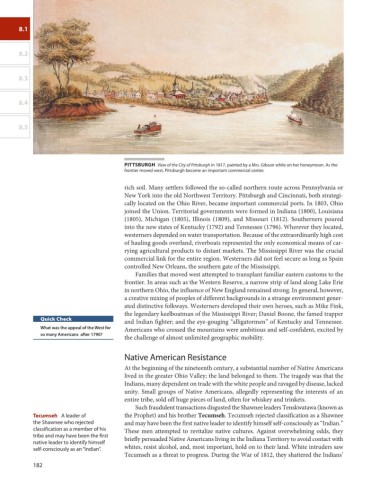Page 215 - American Stories, A History of the United States
P. 215
8.1
8.2
8.3
8.4
8.5
PittsBUrGh View of the City of Pittsburgh in 1817, painted by a Mrs. Gibson while on her honeymoon. As the
frontier moved west, Pittsburgh became an important commercial center.
rich soil. Many settlers followed the so-called northern route across Pennsylvania or
New York into the old Northwest Territory. Pittsburgh and Cincinnati, both strategi-
cally located on the Ohio River, became important commercial ports. In 1803, Ohio
joined the Union. Territorial governments were formed in Indiana (1800), Louisiana
(1805), Michigan (1805), Illinois (1809), and Missouri (1812). Southerners poured
into the new states of Kentucky (1792) and Tennessee (1796). Wherever they located,
westerners depended on water transportation. Because of the extraordinarily high cost
of hauling goods overland, riverboats represented the only economical means of car-
rying agricultural products to distant markets. The Mississippi River was the crucial
commercial link for the entire region. Westerners did not feel secure as long as Spain
controlled New Orleans, the southern gate of the Mississippi.
Families that moved west attempted to transplant familiar eastern customs to the
frontier. In areas such as the Western Reserve, a narrow strip of land along Lake Erie
in northern Ohio, the influence of New England remained strong. In general, however,
a creative mixing of peoples of different backgrounds in a strange environment gener-
ated distinctive folkways. Westerners developed their own heroes, such as Mike Fink,
the legendary keelboatman of the Mississippi River; Daniel Boone, the famed trapper
Quick Check and Indian fighter; and the eye-gouging “alligatormen” of Kentucky and Tennessee.
What was the appeal of the West for Americans who crossed the mountains were ambitious and self-confident, excited by
so many Americans after 1790?
the challenge of almost unlimited geographic mobility.
Native American Resistance
At the beginning of the nineteenth century, a substantial number of Native Americans
lived in the greater Ohio Valley; the land belonged to them. The tragedy was that the
Indians, many dependent on trade with the white people and ravaged by disease, lacked
unity. Small groups of Native Americans, allegedly representing the interests of an
entire tribe, sold off huge pieces of land, often for whiskey and trinkets.
Such fraudulent transactions disgusted the Shawnee leaders Tenskwatawa (known as
tecumseh A leader of the Prophet) and his brother Tecumseh. Tecumseh rejected classification as a Shawnee
the Shawnee who rejected and may have been the first native leader to identify himself self-consciously as “Indian.”
classification as a member of his These men attempted to revitalize native cultures. Against overwhelming odds, they
tribe and may have been the first briefly persuaded Native Americans living in the Indiana Territory to avoid contact with
native leader to identify himself
self-consciously as an “Indian”. whites, resist alcohol, and, most important, hold on to their land. White intruders saw
Tecumseh as a threat to progress. During the War of 1812, they shattered the Indians’
182

